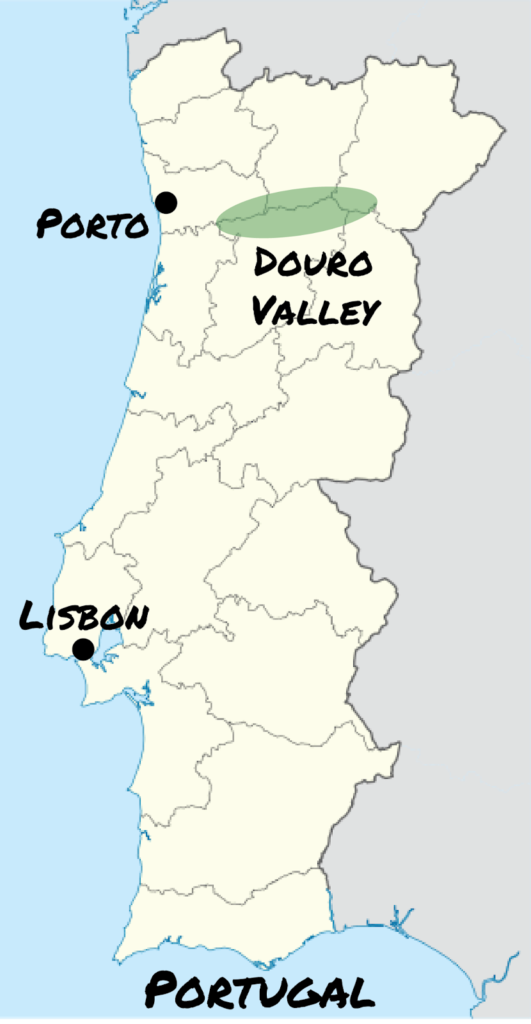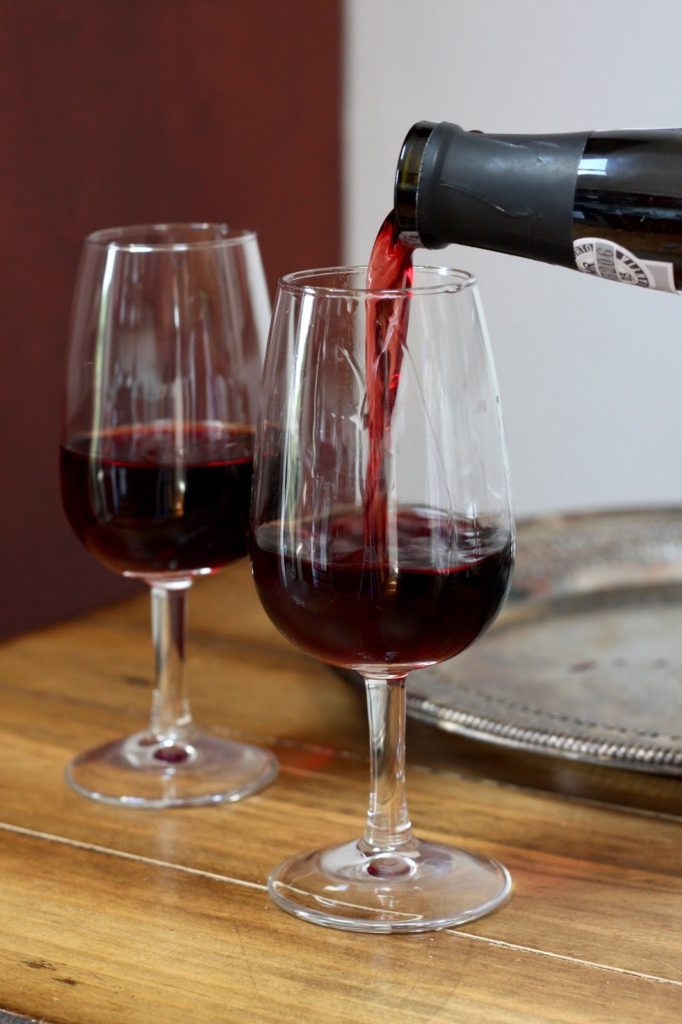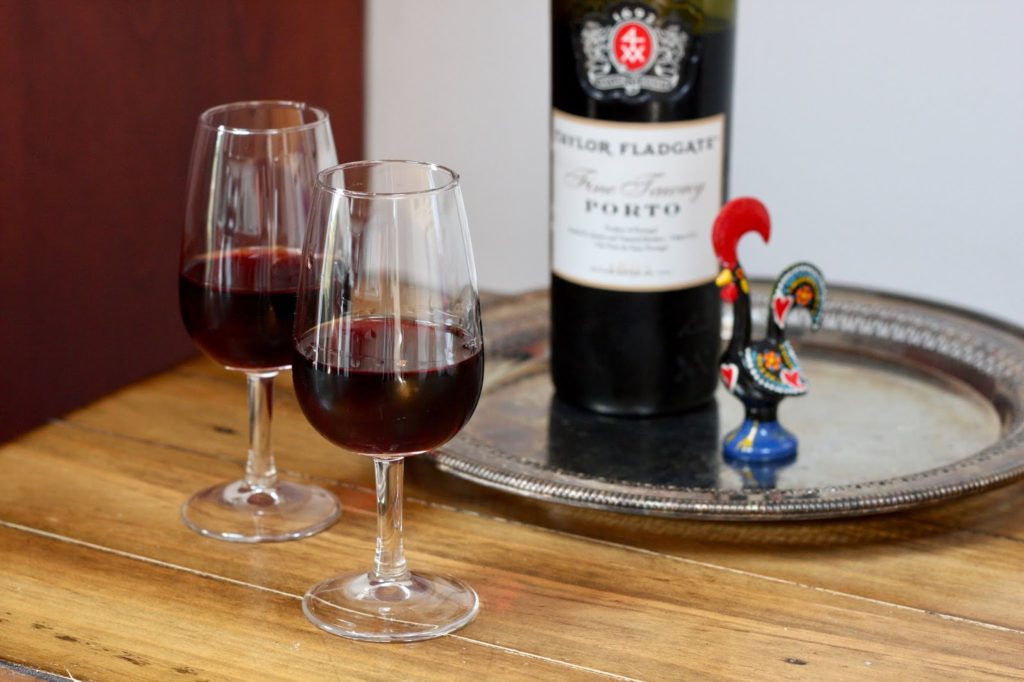 |
| A couple of glasses of Tawny Port along with a Galo de Barcelos, one of Portugal’s emblems |
If you follow me on Instagram, you know that I went to Portugal a couple of weeks ago with my husband and our nine-month-old son. It was our first major trip with the baby, so we tried not to be too ambitious. We split our five days between Porto and Lisbon, and spent most of our time just exploring, eating, and drinking. It was honestly a perfect vacation. Both cities were beautiful. It’s true that the buildings were a bit more run-down than other places I’ve been in Europe, but something about the crumbling plaster, artful graffiti, and smatterings of decorative tile felt romantic and genuine. The food was absolutely incredible – tons of fresh seafood prepared every way imaginable.
And then of course there was the Port. I’ve never known much about Port wine, but I was eager to do some tours in Porto and learn. And now I’m excited to share some of that knowledge with all of you!
 |
| Buildings in Porto on the banks of the Douro River |
If you do know anything about Port, you probably know that it’s a sweet dessert wine. And this is basically true. More specifically, Port is a fortified wine, meaning that a higher-proof spirit is added to it during fermentation. Other fortified wines include sherry, vermouth, and madeira.
All of the grapes for Port are grown in the Douro Valley in Portugal. There are dozens of different varietals that grow in the schist soil of the valley, which creates ideal conditions for the vines. There, they are harvested and crushed – traditionally by foot – to extract their juices. The pressed grapes, including the skins and stems, are then allowed to ferment for a few days. I’m going to pause here because this next part is what makes Port so different from other wines, but it won’t make sense if you don’t have a basic understanding of the process of fermentation. And you should, because it’s what makes alcohol.
Every alcoholic beverage you enjoy is the result of the toil of hard-working little organisms called yeasts who just want you to have fun and be happy. Ok, that’s not true. All they want is to convert sugar into energy so they can keep living their tiny little single-celled lives. But, lucky for us, one byproduct of this process – called fermentation – is alcohol. Those fantastic little yeasts are responsible for all the wine, beer, and spirits you’ve ever had.
In traditional wine, the yeast is allowed to consume all of the sugar from the crushed grapes and convert it into alcohol. But when making Port, fermentation is halted with the addition of a neutral grape spirit called aguardente. This is known as fortifying the wine. Stopping fermentation before the yeasts have finished their job means that there will be lots of residual sugars left over, which is what gives Port its sweetness. The addition of the higher-proof spirit also raises the alcohol content, from around 7% to 20%.
After fermentation and fortification, the wine is shipped down river to the city of Porto to be aged. This is the origin of its name. Although the Port cellars are not officially in the city of Porto at all – they are located on the south bank of the Douro, in the town of Vila Nova de Gaia. Standing on the bank of the river in Porto, you can look across and see the signs for several of the major houses. The cooler climate in Porto is ideal for aging the wine, and its location on the coast makes export easy. The differences between Port varieties come mainly from aging and blending, so these cellars are where a lot of the magic happens.
 |
| Vila Nova de Gaia from the north bank of the Douro River. If you look closely you can see some of the signs for the Port houses – Sandeman is near the center. |
Types of Port
Ruby Port
After arriving in Vila Nova de Gaia, the wine is placed into huge oak casks and allowed to age for up to three years. Ruby Port is a blend of wines aged this way. The shorter aging period in the larger cask means the wine has less contact with the oak and with oxygen, giving it a vibrant red color and a fresh, juicy flavor of ripe fruits.
Reserve Port is a premium Ruby Port that has been given a special designation by the Instituto dos Vinhos do Douro e Porto (IVDP). It seems like these Ports are often given catchy names, like Fonseca Bin 27 or Graham’s Six Grapes. But they will also say Reserve on the label.
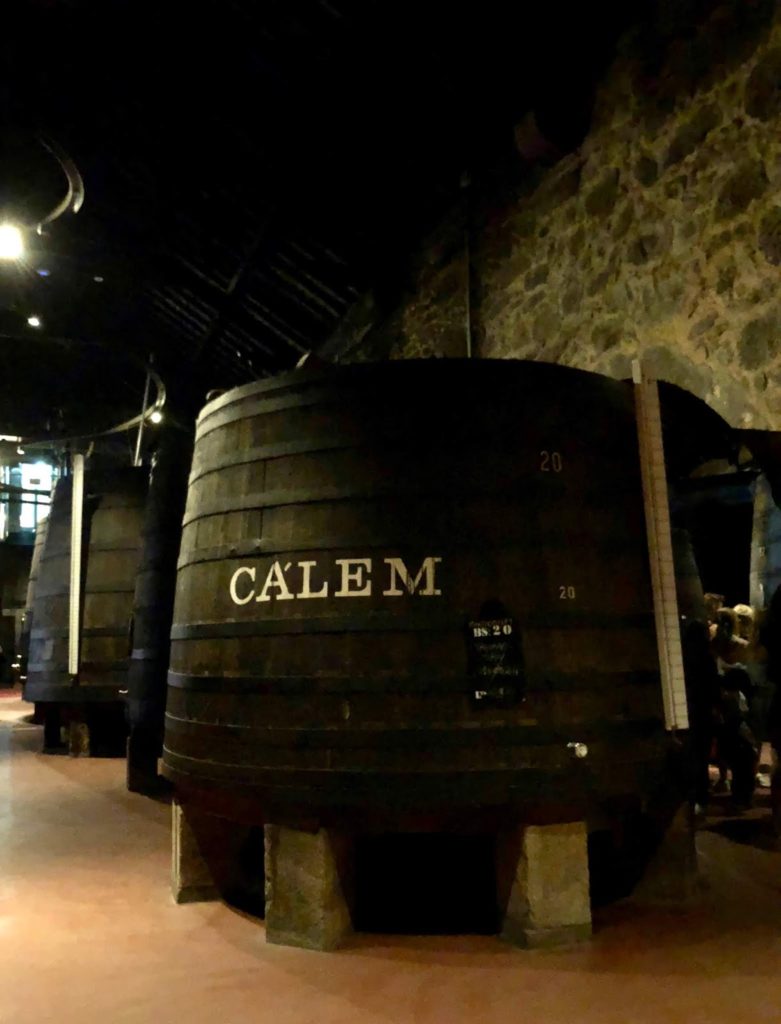 |
| One of the large oak aging vats at Porto Cálem |
Tawny Port
After that initial aging in large casks, some of the wine is transferred into smaller casks and allowed to continue to age, sometimes for decades. These older wines are blended to make Tawny Port. The additional time in oak, and the additional contact with the wood and air that the smaller casks provide, make the wine deeper and more amber in color, bringing out flavors of dried fruits and nuts. Most bottles of Tawny will have an age statement (10, 20, 30 years or longer). Unlike with whisky and rum, where this is the age of the youngest spirit in the bottle, here it indicates an average age of all the wines in the blend. If there is no age statement, that indicates a younger Tawny, usually around three years. Longer aging lightens the color of the wine and intensifies flavors of nuts and spices.
You may also encounter Colheita Tawnies. These are Tawny Ports that contain only grapes from a single harvest.
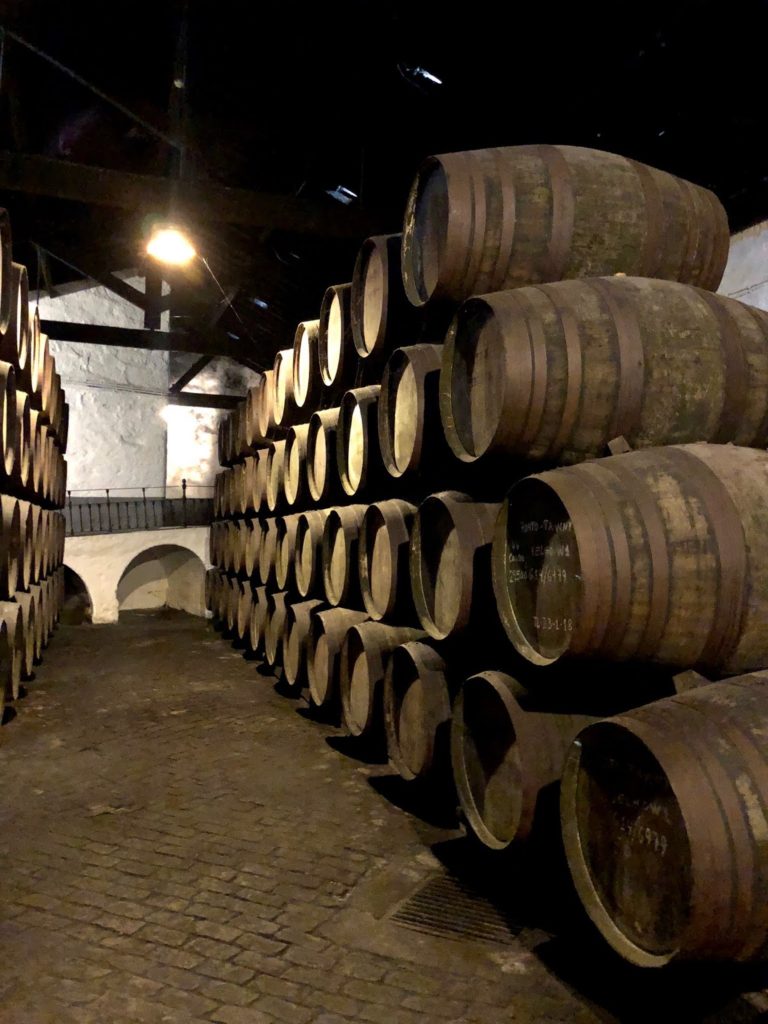 |
| Smaller aging casks at Porto Ferreira |
Vintage Port
After particularly good harvest years, the wine will be tasted after a short period of aging. If it meets certain standards, it can be declared a Vintage year for that estate by the IVDP. Wine from these years is bottled unfiltered after only a couple of years, allowing it to continue aging in the bottle. It always comes from a single harvest and a single year, which will be printed on the label. Most recently, both 2011 and 2016 were declared vintage years for many producers. Bottles dating back to the 1800’s can still be purchased.
Because Vintage Port isn’t aged very long in oak, it is more similar to a Ruby Port than a Tawny in flavor. It should be allowed to continue aging in the bottle for several years before drinking. This is a good Port to buy and save for a special occasion.
Late Bottled Vintage (LBV)
LBV Port is basically wine that wasn’t quite good enough to achieve Vintage status but was still really darn good after aging a bit longer. It too comes from a single harvest and is often bottled unfiltered so that it will continue to age in the bottle like a Vintage Port. This designation was developed in the 1950’s when producers had more Vintage Port than they could sell. They allowed it to age a bit longer before bottling and called it an LBV.
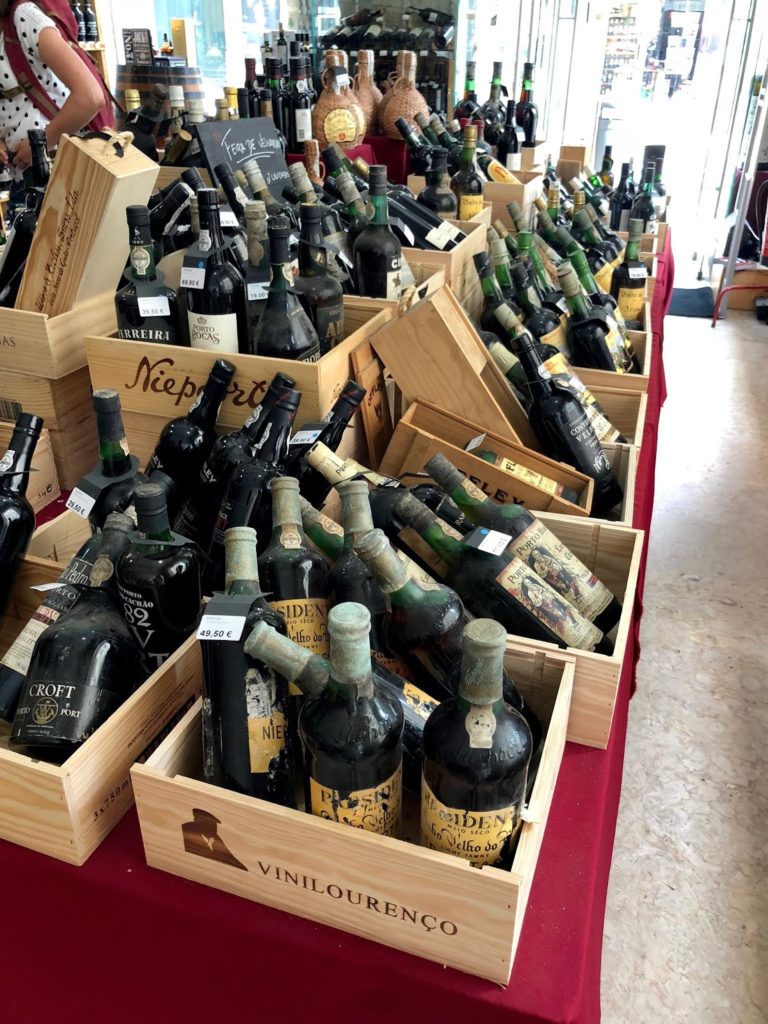 |
| Dusty Port bottles for sale at a store in Lisbon |
White Port
As with any other wine, some of the grapes used to make Port have been cultivated for white varieties. White Port is made much like the red varieties, although some of the cellars we visited aged their White Port in stainless steel rather than oak. Unlike red Port, which as far as I know is always sweet, some White Port is allowed to ferment longer so that it is drier (like the Fonseca Siroco I served at my Port Party in May). Sweet White Port can be aged for various lengths of time, some as long as a Tawny. It becomes a darker, deeper gold color as it ages.
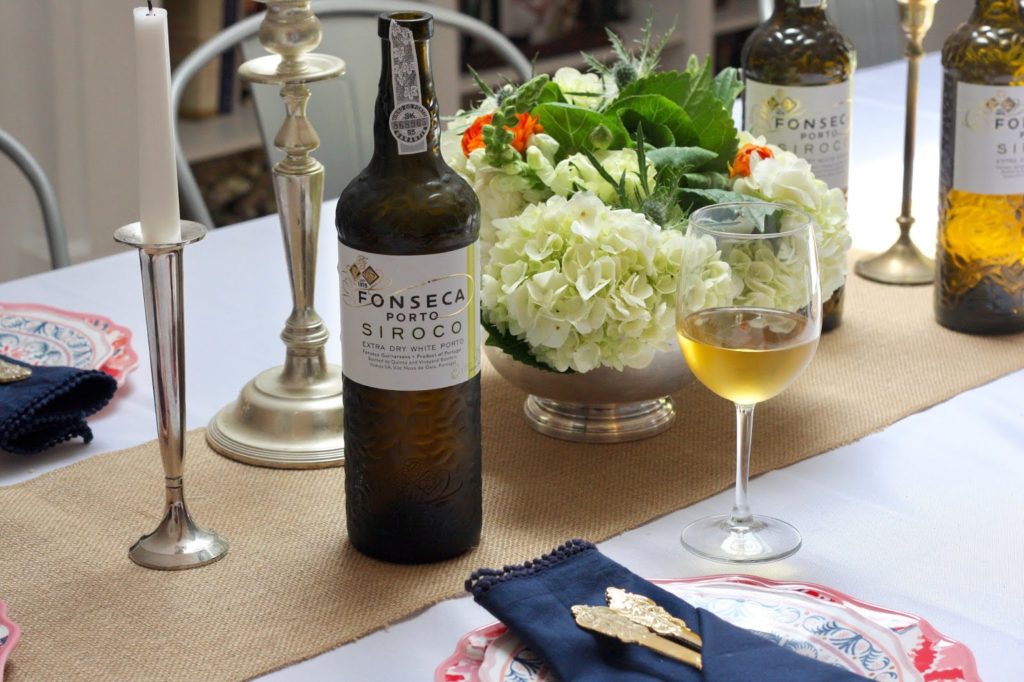 |
| Fonseca Siroco, a dry white Port |
Rosé Port.
A newer invention, Rosé Port is made the same way as rosé wine – by limiting contact with the grape skins during fermentation. It’s light and fruity, usually drier than most Port and perfect as an aperitif. The first house to bottle a rosé was Croft, and many more have followed suit as the rosé craze has taken off.
How to Drink Port
Since it is quite sweet, Port is usually served after dinner with dessert or a cheese course. In Porto, however, it seemed to be enjoyed just about any time. I think it’s nice for a rainy afternoon. It pairs well with strong cheese, nuts, dried fruit, and chocolate. It’s usually served in a distinctively-shaped, narrow stemmed glass at just below room temperature.
The exceptions to all of this are dry White Port and Rosé Port, which are better served chilled as aperitifs. White Port and Tonic is a very popular cocktail in Portugal and beyond.
Once opened, Port should be stored in the refrigerator to prolong its shelf life. Vintage and unfiltered LBV Ports are only good for a day or two once opened, but Ruby Port lasts for several weeks, and Tawny can be good for several months.
When shopping for Port, you’ll probably notice that you could spend anywhere from $10 to hundreds of dollars. There’s no need to spring for a Vintage or a 40-year-old Tawny if you’re just getting into Port. Quality Port is not very expensive, and you can get a decent bottle of Ruby or Tawny for $15-25. Popular brands include Taylor Fladgate, Fonseca, Croft, Sandeman, Ferreira, Dow, and Graham’s. It can be hard to find a big variety, but most liquor stores and wine shops will have a few bottles. Pick one up – and let me know what you think!
In addition to the tours I took in Portugal, the information in this post came mainly from here, here, and here.






